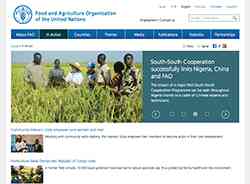The importance of machines and tools in sustainable agriculture

Ensuring that agricultural and food production is sustainable is at the core of FAO’s work. Within this, sustainable mechanization plays an increasingly important role. In essence, sustainable mechanization is the practice of introducing the proper machinery to farmers to ensure that their agricultural production is not only more environmentally sustainable but is more efficient in growing crops.
Sustainable agricultural mechanization refers to all farming and processing technologies from basic hand tools to motorized equipment. It does not just look at the technical aspects of farming, it also takes into account the effect that tools have on a farmer’s outputs, from crop production along the value chain to marketable products, and in turn, the impact this has on a farmer’s income.
With its partners, FAO has taken a hands-on approach in promoting sustainable mechanization by providing training to farmers on using appropriate tools, equipment and machinery and on environmentally-sound agricultural practices. FAO also works with governments, service providers and farmer organizations to develop strategies that support the implementation of sustainable mechanization at the local level. Additionally, FAO provides quality control on the tools provided to the farmers to verify that they are appropriate, safe and durable. By forming partnerships with governments and the private sector, FAO is ensuring that information on sustainable mechanization is disseminated at all levels, from government actors to the farmers themselves.
Holistic View of Sustainability
Sustainable agricultural mechanization takes a holistic view on agriculture; it looks at sustainability within the technical, environmental and economic contexts. By ensuring that farming tools are environmentally sound, economically affordable, adaptable to local conditions, and resilient in terms of changing weather patterns and climate, mechanization looks to achieving larger and better harvests and increased income or new jobs for farmers.
Moving on from subsistence farming
By increasing harvest outputs, mechanization means that famers can move on from subsistence farming to market-oriented farming. This in turn appeals to the rural youth who increasingly seek employment in urban settings rather than in the fields. By easing and reducing the hard labour involved with farming, mechanization can also ensure higher outputs regardless of the age, gender or physical well-being of the farmer. It can also relieve labour shortages, improve timeliness of agricultural operations, ensure the efficient use of resources, enhance market access by allowing farmers to sell more than just the raw product and contribute to mitigating environmental damage such as soil degradation. Machines can allow for better practices such as reduced tillage and inter-cropping, the practice of planting different types of crops (e.g. legumes / cereals) in one field that grow simultaneously and complement each other in their growth. Rotational and inter-cropping practices reduce the risk of pests, soil degradation and the effects of unfavorable climate conditions.
Intensification without degradation
With the earth’s growing population, there is greater demand for agricultural products. At the same time, the planet is facing serious challenges due to exploitation of natural resources and the increasing effects of climate change. Designating appropriate machines and tools to the agricultural production chain is vital to increasing outputs in a sustainable way. Carefully chosen machinery can allow crops to be grown and harvested with minimum-to-no soil disturbance, ensure that the soil surface remains protected by organic cover, manage crop rotations to enhance soil health and conserve crop nutrients.
Fitting the tools to the needs
The type and size of machinery made available to farmers is also crucial. Past initiatives that worked with donated or subsidized machinery rather than machinery that was best suited to the situation often proved unsustainable as the repair services or replacement parts were not often available. Cheap at the outset, this solution proved unnecessarily expensive as these machines, once broken, ended up in graveyards full of tractors and equipment that could not be fixed and new ones had to be bought instead. It is for cases such as these that it is imperative that a well-defined sustainable mechanization strategy is in place prior to its implementation. In December 2016, FAO met with local and international partner organizations to help establish a Sustainable Mechanization Framework for Africa. This framework provides best practices and strategy options that can be adapted to local conditions, a crucial element in ensuring its success.
Sustainable mechanization: a means to an end
Ensuring that farmers have access to and knowledge of appropriate machinery and tools for their farming practices is critical to agricultural sustainability. FAO is working with private sector partners, governments and farmers to create and promote sustainable mechanization opportunities. You can read more about FAO’s work on sustainable agricultural mechanization in sub-Saharan Africa in this publication.
Or visit our dedicated site for more information on FAO’s work in sustainable mechanization.